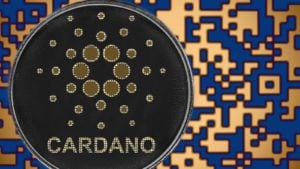InvestorPlace - Stock Market News, Stock Advice & Trading Tips
Cardano (CCC:ADA-USD) has a unique proof-of-stake system for its cryptocurrency, which uses the increasingly popular ADA altcoin token. In fact, ADA was recently allowed for trading on the Coinbase (NASDAQ:COIN) trading network, the most popular crypto exchange in the U.S.

Source: Shutterstock
As of April 17, the Cardano coin ADA was trading at $1.39 per coin. This is 7.7 times its price of 18 cents as of Jan. 1, 2020. In fact, in the last month from March, when ADA was at $1.38, Cardano has risen just 1 cent or just 0.72%.
By contrast, Ethereum (CCC:ETH-USD), a proof-of-work altcoin that is slowly moving to a proof-of-stake system, has risen from $1,823 a month ago to $2,377 as of April 17. That represents a 30.3% gain in the past month.
Nevertheless, Cardano remains one of the larger altcoins, and certainly, the largest committed to a proof-of-stake system. For example, Coinmarketcap indicates that Cardano is the sixth-largest cryptocurrency with a market cap of $44.898 billion, and a circulating supply of $31.948 billion.
Cardano’s Proof-of-Stake System
The proof-of-stake system means that there is no mining with ADA coins awarded to truth attestors of any block in the blockchain. According to Coindesk, is it an alternative way compared to proof-of-work cryptos like Bitcoin to maintain the integrity of a cryptocurrency. It allows the cryptocurrency blockchain to maintain this integrity by preventing crypto holders from using their coins twice or more in any blockchain of transactions.
Although Ethereum has plans to move to a proof-of-stake system it still has not completed this transformation. The first step was Ethereum 2.0 in December 2020, but it is not clear yet, according to Coindesk, how long the conversion will take.
The key way that a proof-of-stake system like Cardano works is that certain “validators” put up a stake of their cryptocurrency to attest to the validity of a block in the blockchain. Through this staking system, validators earn a certain amount of the crypto as a reward.
This apparently saves electricity and other green advantages compared to the proof-of-work systems. For example, Bitcoin’s system requires heavy use of electricity to mine and solve algorithm hashes in order to validate blocks in a blockchain for crypto rewards.
Cardano uses a proof-of-stake system called the ouroboros system. It rewards validators through a series of random and selected rewards. Right now it is not clear, through reading the research, how much stake the validators of a block have to stake. For example, at Ethereum the validators have to stake 32 Ether, today worth about $80,000, to become a validator.
What To Do With Cardano
The best thing to do with these altcoin cryptocurrencies is to take a diversified approach to invest in them. (This, of course, assumes that you are willing to invest in cryptos in the first place.)
For example, purchase a certain amount, according to your portfolio budget, of both Bitcoin and Ethereum. These cryptos have the highest chance of success so far. But it makes sense to diversify into these altcoins like the Cardano ADA coin, just in case one of them takes off, just like Ethereum has done recently.
How do you do this? One of the easiest ways to buy ADA coins is to set up an account with Coinbase, which recently went public. This is because not many of the main brokerage firms yet allow you to buy ADA coins.
However, as I pointed out above, just because Cardano has a proof-of-stake system does not require you to have to stake your ADA coins. You can continue to hold your ADA in Coinbase or any other digital wallet that allows you to hold them and wait for price appreciation.
You can also potentially use the ADA coins for the crypto settlement of a transaction. In fact, soon the Cardano blockchain, just like Ethereum, will allow smart contracts to be kept used. Either way, by buying Cardano ADA coins you are supporting a new way of producing cryptocurrency through their proof-of-stake system.
On the date of publication, Mark R. Hake held a long position in Bitcoin (BTC-USD), Ethereum (ETH-USD), and Coinbase (COIN).
Mark Hake writes about personal finance on mrhake.medium.com and runs the Total Yield Value Guide which you can review here.
The post Why Cardano’s Proof-of-Stake System Is Unique for a Cryptocurrency appeared first on InvestorPlace.
The views and opinions expressed herein are the views and opinions of the author and do not necessarily reflect those of Nasdaq, Inc.


